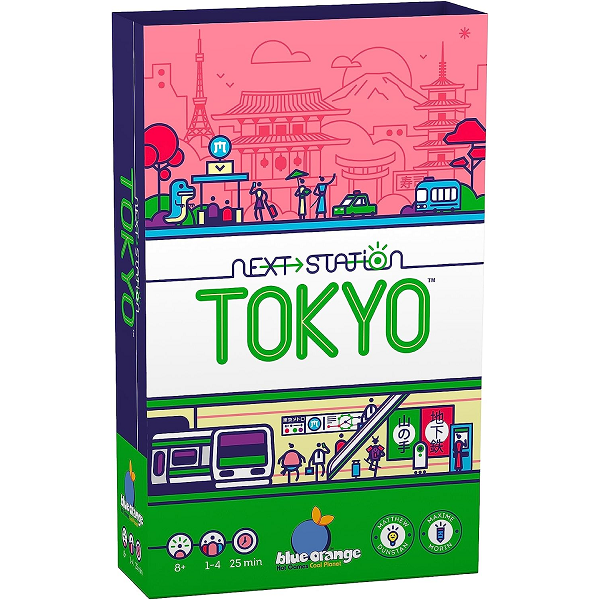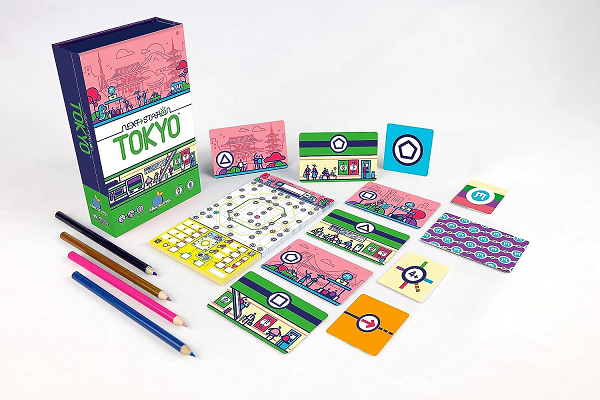Let's Build a Subway in Next Station: Tokyo

A sequel to the 2023 Spiel des Jahres Nominee Next Station: London, this new game brings a few different scoring elements to the table.
Published by Blue Orange Games and designed for 1-4 players, Next Station: Tokyo plays in roughly 25 minutes and is a flip-and-write game all about building subway lines across a map of Tokyo.
Gameplay
Each player receives a map sheet. Over the course of four rounds, you will be drawing four subway lines, each of a different color that corresponds to the four different colored pencils in the game. For each round, each player takes a different colored pencil, which determines which subway line they will be drawing that round. The starting station for each line is marked on your sheet. Your sheet also shows the green central loop line, already complete, that runs through eight stations.
Every round consists of 5-10 turns. Each turn a station card is drawn. There are 4 types of stations, each represented by a different symbol. Each station card will show one of these symbols. Each player can choose to skip a turn or extend their line to a station showing the drawn symbol.
When extending a line, you must start from one end of your subway line and draw a straight line to a station showing the symbol on the card. You must follow one of the grey potential lines depicted on the map that run between the stations. You cannot go through another line or visit a station that this subway line already visits, and you cannot follow a grey line that another line already follows.
There are a couple of special station cards. One is a joker that allows you to choose any station symbol. The joker also allows you to draw the line along another subway’s track. The other special station card is the railroad switch symbol, which allows you to draw a line off of any station on your subway’s route, and not just from one of its two ends.
New station cards are drawn until five specially marked ones have been revealed and the round ends. You then calculate how many points your line is worth. The map is divided into 13 districts. To calculate how many points your subway line is worth, you count how many districts it goes through, and multiply that by the number of stations it visits in the district in which it has the most stations. You then take a new colored pencil to start your next subway line, and the next round begins.
After four rounds, the game ends. You add up all the points from each of your four lines. You also check for interchanges. Interchanges are stations where more than one subway line meets. Stations with three lines meeting are worth 5 points, four lines are worth 15 points, and 5 lines are worth 30 points. You then lose 3 points for each station on the green central loop line that does not intersect with at least one other subway station.
Finally, the eight districts around the outside of the loop are unique. When you manage to make an interchange station in each one for the first time, you score a set number of points.
The player with the most points wins the game.

Photo provided by the publisher
Review
Next Station: Tokyo brings a few new ideas to the gameplay of Next Station: London, mixing things up a little, while still at its heart being the same game.
The green central loop is probably the biggest tweak to the mechanics. You’re already trying to make connections between the loops to score points for interchanges, but the risk of actually losing points means you’re focusing a lot more on the center of the sheet, which in turn increases the likelihood of accidentally cutting yourself off, while the joker card can get you out of a tough spot if its drawn at the right time.
Next Station: Tokyo offers a lot of variability, just from which cards are drawn in what order, for which line you’re currently working on. Since each player is also working on a different line each round, each player’s sheet is going to end up looking quite different. It’s in how to make the most out of each card draw that the challenge of the game lies.
Additionally, there are advanced variants you can play with, from objectives that players must try to complete to special station cards which give certain station symbols special abilities when they’re drawn. This allows players to adjust the complexity of the game and further adds to the variability.
If you love Next Station: London, Tokyo brings enough new ideas to the table to justify getting it. But it’s the same core gameplay so if you don’t like the original, or find you don’t play it that often, it’s not going to be worth adding Tokyo to your collection. London is probably a better one to start with, since it’s a little simpler, but Tokyo is a solid sequel that more than holds its own and still remains nicely accessible. We’ll be eager to see if Next Station visits any more cities in the future!
Pros: A few new mechanics add some new elements to the scoring, plenty of variation between game sessions
Cons: Not quite different enough to London to change your mind if you didn’t like the original
Disclosure: we received a complimentary review copy of this game.







